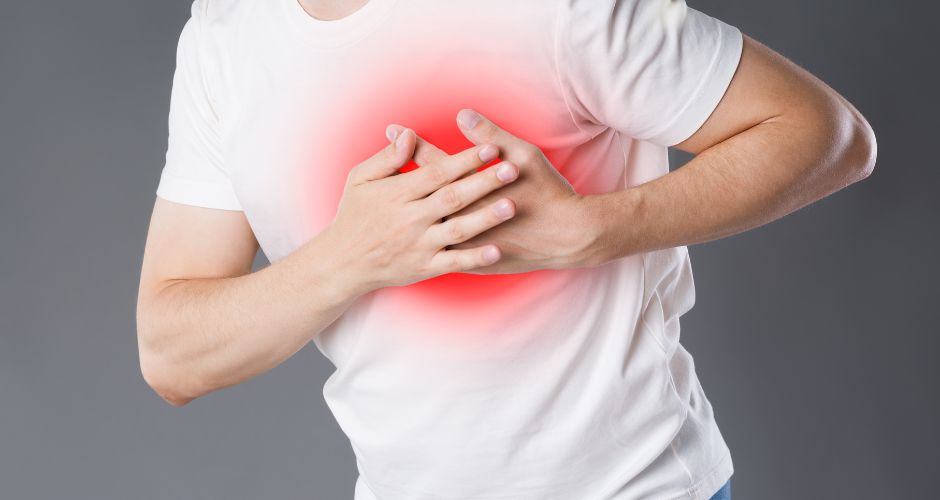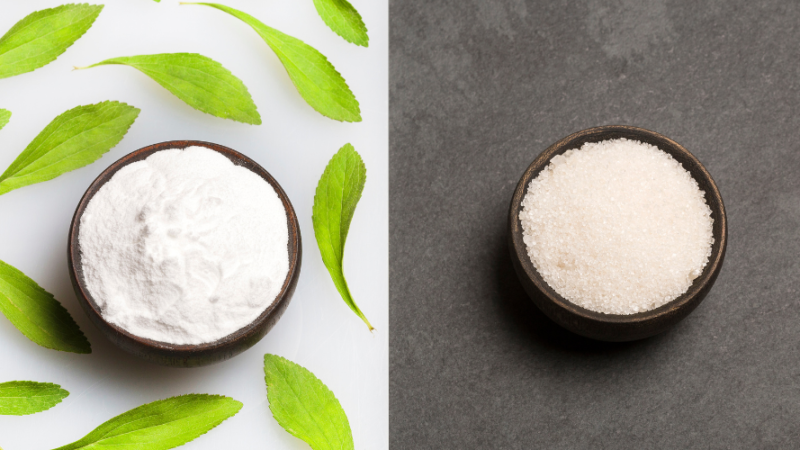Panic Attack vs. Heart Attack : Difference

Imagine suddenly feeling an intense rush of fear, accompanied by chest pain and difficulty breathing. In such moments, it’s natural to fear the worst – could it be a heart attack? Or perhaps just a panic attack? Distinguishing between these two conditions can be challenging, yet crucial for appropriate response and treatment.
In this blog post, we’ll delve deep into the nuances of panic attacks and heart attacks, exploring their distinct characteristics, symptoms, and how to tell them apart.
What is a Panic Attack?
A panic attack is a sudden surge of intense fear or anxiety that triggers a series of physical and emotional symptoms. These episodes can be frightening and may feel like a sudden wave of terror or impending doom, even when there’s no real danger present. Panic attacks typically peak within a few minutes but can last longer, leaving individuals feeling exhausted and emotionally drained afterward.

Symptoms of a Panic Attack
- Chest Pain or Discomfort: This can feel like tightness, pressure, or a sharp pain in the chest.
- Shortness of Breath: Difficulty breathing or feeling like you’re choking or suffocating.
- Heart Palpitations: Rapid or irregular heartbeat, often accompanied by a sensation of fluttering or pounding in the chest.
- Sweating and Trembling: Profuse sweating, trembling, or shaking, especially in the hands or legs.
- Feeling of Loss of Control: Fear of losing control or going crazy.
- Dizziness or Lightheadedness: Feeling faint, dizzy, or lightheaded, sometimes accompanied by nausea.
- Hot or Cold Flashes: Sudden sensations of heat or coldness throughout the body.
- Numbness or Tingling Sensations: Particularly in the hands, feet, or face.
- Fear of Death or Impending Doom: Intense fear of dying or feeling like something terrible is about to happen.
Reasons Behind Panic Attacks
Panic attacks can be triggered by various factors, including:
- Stress and Anxiety: High levels of stress or anxiety can overwhelm the body’s natural coping mechanisms, leading to a panic attack.
- Genetics: Individuals with a family history of panic disorder or anxiety disorders may be more prone to experiencing panic attacks.
- Traumatic Events: Past traumatic experiences or unresolved emotional issues can increase the likelihood of panic attacks when triggered by similar situations or stimuli.
- Medical Conditions: Certain medical conditions, such as thyroid disorders or respiratory conditions, can contribute to the onset of panic attacks.
Prevention and Management of Panic Attacks
Panic attacks can be distressing and disruptive, but there are steps you can take to reduce their frequency and severity. Here are some prevention and management strategies to help you cope with panic attacks:
- Identify Triggers: Pay attention to situations, thoughts, or emotions that trigger your panic attacks. Once you identify your triggers, you can work on strategies to avoid or manage them effectively.
- Practice Relaxation Techniques: Learning relaxation techniques such as deep breathing, progressive muscle relaxation, and mindfulness meditation can help calm your mind and body during a panic attack. Practice these techniques regularly to build resilience and reduce the intensity of panic attack symptoms.
- Maintain a Healthy Lifestyle: Prioritize your physical health by eating a balanced diet, getting regular exercise, and prioritizing sleep. A healthy lifestyle can help reduce stress and anxiety, which are common triggers for panic attacks.
- Seek Professional Help: If you’re struggling to manage your panic attacks on your own, don’t hesitate to seek professional help. A therapist or counselor can teach you coping strategies, provide support, and help you address underlying issues contributing to your panic attacks.
- Consider Medication: In some cases, medication may be prescribed to help manage symptoms of panic attacks. Antidepressants, anti-anxiety medications, and beta-blockers are commonly used to treat panic disorder. Talk to your doctor about whether medication is a suitable option for you.
- Practice Self-Care: Engage in activities that promote relaxation and well-being, such as spending time with loved ones, pursuing hobbies, or enjoying nature. Taking care of yourself emotionally and mentally can help reduce your vulnerability to panic attacks.
- Develop a Support Network: Surround yourself with supportive friends, family members, or support groups who understand your struggles with panic attacks. Having a strong support network can provide encouragement, validation, and practical assistance during difficult times.
- Stay Prepared: Keep a small kit or bag with comforting items such as water, snacks, a stress ball, or a favorite book to help you cope with panic attacks when they occur. Knowing that you have tools and resources readily available can provide a sense of security and control.
Recommended – How to Deal with Dental Phobia or Anxiety?
What is a Heart Attack?
A heart attack occurs when a coronary artery, which supplies blood to the heart muscle, becomes blocked or narrowed, usually by a buildup of plaque (atherosclerosis). This blockage prevents oxygen-rich blood from reaching a portion of the heart muscle, leading to tissue damage or death. The severity of a heart attack can vary depending on the extent of the blockage and the duration of the blood flow interruption.
Symptoms of a Heart Attack
- Chest Pain or Discomfort: The most common symptom of a heart attack is chest pain or discomfort. This may feel like pressure, tightness, squeezing, or pain in the center of the chest that lasts more than a few minutes or goes away and comes back.
- Pain or Discomfort in Other Areas: In addition to chest pain, discomfort may be felt in other areas of the upper body, including the arms, back, neck, jaw, or stomach. This pain or discomfort may radiate from the chest and can vary in intensity.
- Shortness of Breath: Difficulty breathing or feeling like you can’t catch your breath is another common symptom of a heart attack. This may occur with or without chest pain and can be accompanied by a feeling of suffocation or air hunger.
- Nausea, Indigestion, or Heartburn: Some people may experience symptoms such as nausea, vomiting, indigestion, or heartburn during a heart attack. These gastrointestinal symptoms may occur alone or in combination with other symptoms.
- Cold Sweats: Profuse sweating, especially with other symptoms like chest pain or shortness of breath, can be a sign of a heart attack. This cold, clammy sweat may occur suddenly and without exertion.
- Lightheadedness or Dizziness: Feeling lightheaded, dizzy, or faint is another symptom that may accompany a heart attack. This may occur in conjunction with chest pain or shortness of breath and may be a sign of decreased blood flow to the brain.
Reasons Behind Heart Attacks
Heart attacks typically occur due to underlying cardiovascular issues, including:
- Coronary Artery Disease (CAD): The most common cause of heart attacks is the narrowing or blockage of coronary arteries due to plaque buildup, known as coronary artery disease.
- High Blood Pressure: Hypertension can lead to the thickening and narrowing of the arteries, increasing the risk of heart attacks.
- High Cholesterol: Elevated levels of cholesterol in the blood can contribute to the formation of plaque in the arteries, restricting blood flow to the heart.
- Smoking: Tobacco use damages the blood vessels and increases the risk of atherosclerosis, making smokers more susceptible to heart attacks.
- Obesity and Lack of Physical Activity: Sedentary lifestyles and obesity are significant risk factors for heart disease and heart attacks.
- Diabetes: Individuals with diabetes are at higher risk of heart attacks due to the effects of high blood sugar on blood vessels and the heart.

Prevention and Management of Heart Attacks
Preventing a heart attack involves making healthy lifestyle choices and managing underlying risk factors. Additionally, knowing how to recognize the symptoms of a heart attack and taking prompt action can be life-saving. Here are some key strategies for preventing and managing heart attacks:
- Healthy Diet: Adopt a heart-healthy diet rich in fruits, vegetables, whole grains, lean proteins, and healthy fats. Limit intake of saturated and trans fats, cholesterol, sodium, and added sugars.
- Regular Exercise: Engage in regular physical activity, aiming for at least 150 minutes of moderate-intensity aerobic exercise or 75 minutes of vigorous-intensity exercise per week. Incorporate activities that raise your heart rate and strengthen your cardiovascular system.
- Maintain a Healthy Weight: Aim for a healthy weight by balancing calorie intake with physical activity. Losing excess weight, particularly around the abdomen, can reduce the strain on your heart and lower your risk of heart disease.
- Quit Smoking: Smoking is a major risk factor for heart disease and heart attacks. Quitting smoking can significantly reduce your risk and improve your overall health. Seek support from healthcare professionals or smoking cessation programs if needed.
- Manage Stress: Chronic stress can contribute to heart disease. Practice stress-reducing techniques such as deep breathing, meditation, yoga, or spending time in nature. Find healthy ways to cope with stress and prioritize self-care.
- Control High Blood Pressure: High blood pressure can damage arteries and increase the risk of heart disease. Monitor your blood pressure regularly and work with your healthcare provider to manage it through lifestyle changes, medication, or a combination of both.
- Manage High Cholesterol: High levels of LDL cholesterol can lead to plaque buildup in arteries, increasing the risk of heart attacks. Follow a heart-healthy diet, exercise regularly, and take medication as prescribed to control cholesterol levels.
- Manage Diabetes: Diabetes increases the risk of heart disease. Monitor blood sugar levels closely, follow a diabetic meal plan, exercise regularly, take medication as prescribed, and attend regular check-ups with your healthcare provider.
- Limit Alcohol Intake: Excessive alcohol consumption can raise blood pressure and increase the risk of heart disease. Limit alcohol intake to moderate levels or avoid it altogether to protect your heart health.
- Know the Symptoms: Familiarize yourself with the symptoms of a heart attack, including chest pain or discomfort, shortness of breath, nausea, lightheadedness, and pain or discomfort in the arms, back, neck, jaw, or stomach.
- Seek Immediate Medical Attention: If you experience symptoms of a heart attack, call emergency services immediately. Do not delay seeking help, as prompt treatment can save lives.
Panic Attack vs. Heart Attack
While panic attacks and heart attacks can share similar symptoms, there are key differences to be aware of:
| Panic Attack | Heart Attack | |
| Onset | Sudden | Gradual |
| Duration | Peaks within minutes | Symptoms may worsen over time |
| Chest Pain | Sharp, stabbing, fleeting | Pressure, squeezing, tightness |
| Breathing | Shortness of breath | Difficulty breathing |
| Palpitations | Common | Common |
| Sweating | Profuse | Cold sweat |
| Trembling | Yes | No |
| Sense of Doom | Often present | Rare |
| Nausea | Sometimes | Common |
| Lightheaded | Rare | Common |
| Radiating Pain | No | Yes, to arms, back, neck, jaw, stomach |
| Duration | Typically subsides within minutes | Symptoms may persist or worsen |
| Treatment | May not require medical attention | Emergency medical attention required |
| Action Needed | Practice self-soothing techniques | Seek emergency medical attention |
Understanding the differences between panic attacks and heart attacks is essential for accurate diagnosis and appropriate response. By familiarizing yourself with the distinct characteristics of each condition, you can confidently navigate symptoms and seek the necessary help when needed. Stay informed, stay vigilant, and prioritize your well-being.
FAQ’s
Q1. Can you die from a panic attack?
A panic attack itself will not lead to death, but it can induce intense feelings of imminent danger. Panic attacks trigger the body’s fight or flight response, heightening alertness. To alleviate panic attack symptoms, practice deep breathing and remember that they are a response to the body’s alert system.
Q2. Can a panic attack cause a heart attack?
A panic attack does not directly cause heart attacks stemming from arterial blockages. Typically, panic attacks subside within a specific timeframe. If symptoms persist, a heart attack could be the underlying cause.
However, stress-induced cardiomyopathy, or “broken heart syndrome,” can occur due to acute stressors. This syndrome triggers a stress response in the heart, often in reaction to distressing news like the loss of a loved one.
Q3. How do you help someone who is having a panic attack?
When someone experiences a panic attack, provide support and guide them to take slow, deep breaths. If it’s their first experience, consider seeking medical assistance to rule out serious conditions like a heart attack. If the individual has previously had panic attacks, offer reassurance, stay with them until symptoms improve, and suggest finding a quiet place to rest.
Q4. How many heartbeats per minute indicate a heart attack?
There isn’t a specific heart rate indicative of a heart attack. During a heart attack, the heart rate can be slow, normal, or fast. The heart adjusts its rate based on signals from the body, increasing during exercise or when the fight or flight response is activated, as seen in panic attacks.
Q5. How long does a heart attack last?
The duration of a heart attack varies. Symptoms may occur intermittently or persist for hours until the blocked artery is treated. It’s essential to seek medical attention promptly if experiencing symptoms of a heart attack to prevent further complications.
Q6. What should you do after a panic attack?
After a panic attack, remind yourself that the symptoms are a normal response to perceived threat. Engage in relaxation techniques such as deep breathing, yoga, or reading. Reflect on potential triggers for the attack, which may vary from specific events to chronic stress levels. Consider seeking talk therapy to develop healthy coping mechanisms for stress and anxiety.






